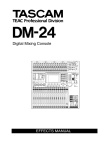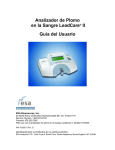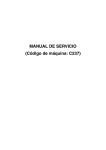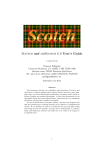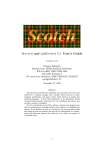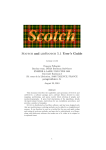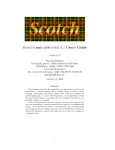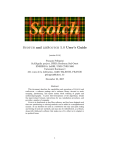Download SLP Command Specification
Transcript
Smart Label Printer Command Interface Specification Version 2.4 Built on 27.July.2007 Change History New Old Ver2.4 Ver 2.3 Ver2.3 Ver 2.2 27.July.2007 26. Jun. 2006 Date Ver 2.2 Ver 2.1 Ver 2.1 Ver 2.0 16. Feb. 2006 20. Oct. 2005 Description - Change a small error and add example in CMD_SETOPTIONS - Change comment in CMD_BAUDRATE(03h), P.7 - Change bit map of initial baud rate table in CMD_SETOPTIONS(1Ch), P.10 - Add comment to “13. Defined Printer Responses”, P.22 Add and delete by support of 300dpi - Add Change history - Update to Contents - Add comment to CMD_SETSPEED - Delete USB ID in CMD_GETOPTIONS - Delete Standby mode (C1) in CMD_SETMODE - Delete the refer to Secondary Color - Delete Demo Mode - Add APPENDIX 1 and 2 Contents 1. Overview.............................................................................................................................................. 3 2. Description........................................................................................................................................... 3 3. Interface ............................................................................................................................................... 3 4. Printer Buffer Size................................................................................................................................ 4 5. RS-232 Handshaking............................................................................................................................ 4 6. Serial Interface Cable ........................................................................................................................... 4 7. Command Code Summary.................................................................................................................... 6 8. Description of "Immediate" Commands................................................................................................ 7 9. Description of "Buffered" Commands................................................................................................. 14 10. RLE Compressed Data...................................................................................................................... 20 11. General Printer Responses ................................................................................................................ 20 12. Status Byte Definitions ..................................................................................................................... 21 13. Defined Printer Responses ................................................................................................................ 22 14. Printer States.................................................................................................................................... 24 15. Feed Button ...................................................................................................................................... 25 16. On-line/Off-line Button .................................................................................................................... 25 17. Auto On-Line ................................................................................................................................... 26 18. General Notes................................................................................................................................... 26 19. Diagnostic Mode .............................................................................................................................. 27 20. Paper Loading .................................................................................................................................. 28 21. Print Speed....................................................................................................................................... 29 22. Printing Sample Labels..................................................................................................................... 29 23. Load factory default values to EEPROM........................................................................................... 30 APPENDIX 1. SLP Printer Hardware States.......................................................................................... 31 APPENDIX 2. USB Parameters............................................................................................................. 32 APPENDIX 2. USB Parameters............................................................................................................. 32 -2- 1. Overview This document describes the general operation of the Smart Label Printer and the interface between the printer and a host computer system. Smart Label Printer is a generic name for a family of printer models, including: • 300dpi wide printers (SLP 440 and SLP 450) • 203dpi wide printers (SLP 200, SLP 240, SLP 420, and SLP 430) • 203dpi narrow printers (SLP 100 and SLP 410) 2. Description The Smart Label Printer is a bitmapped device that prints all information on the label (including text) as graphic images. The command set is very lean in order to allow the printer to concentrate only on printing and off-load the other functions to the host. 3. Interface The Smart Label Printer communicates with the host computer using an RS-232 or USB cable. The supplied RS-232 cable connects the GND, TX, RX, RTS and CTS signals to the printer via a standard RJ-11 modular connector. The host end of the cable is intended for connections using a DB-9 connector. At power-up, the printer’s RS-232 communications port is normally configured for no parity, 8 data bits, and one stop bit. The maximum baud rate for the SLP 100, SLP 200, SLP 240, SLP 410, SLP 420 and SLP 430 models is 57,600 baud. Also, the maximum baud rate for the SLP 440 and SLP 450 models will be 115k baud, but it is 38,400 baud temporary. For USB operation, a standard USB cable may be used instead of the RS-232 cable. The supplied USB cable connects USB signals (Vbus, GND, D+, and D-) to the printer via a standard USB series B connector. The host end of the cable is intended for connections using a standard USB series A connector. The host may change the baud rate to other values by sending a special command to the printer. However, the data format is always 8 data bits, one stop bit, and no parity. The printer’s port is always set to the default baud rate after power-up and after receiving a reset command. The primary communication flow is from the host to the Smart Label Printer. This is because the host must send commands and data, while the Smart Label Printer sends only handshaking signals and an occasional status byte. The Smart Label Printer sends a status byte (unsolicited) to the host computer whenever there is a change in its internal copy of the status byte. A status byte can also be requested by sending the CMD_STATUS command to the Smart Label Printer. Since the status byte is sent automatically whenever it changes, the CMD_STATUS command is rarely -3- used. In case of the USB interface, the Smart Label Printer returns a status byte on receipt of a BULK-IN command from the Host. The status byte is initialized when the printer is reset (by power-up or command). The printer sends the status byte, followed by an XON character, and then sets the RTS signal high. In case of the USB interface, the Smart Label Printer returns a status byte on receipt of a BULK-IN command from the Host. 4. Printer Buffer Size The Smart Label Printer’s input buffer has a capacity of 256 bytes. 5. RS-232 Handshaking When the input buffer is almost full (less than 32 bytes free), the printer will indicate a “buffer full” condition by sending an XOFF character (13h) to the host and setting the RTS signal low. After the “buffer full” condition has occurred and the input buffer has been emptied to the point where there are only 100 bytes of data remaining in the buffer, the printer will indicate a “buffer empty” condition by sending an XON character (11h) to the host and setting the RTS signal high. The buffer full and buffer empty thresholds may be changed with the CMD_XOFF_THRESH and CMD_XON_THRESH commands, respectively. 6. Serial Interface Cable The Smart Label Printer may be connected to the host computer using the interface cable included with the printer. The RS-232 interface cable is wired as follows: Smart Label Printer Signal RJ-11 --1 RD 2 TD 3 GND 4 --5 RTS 6 Wire Color Blue Yellow Green Red, shield Black White Direction --! " # --" -4- PC Host Signal DB-9F ----TD 3 RD 2 GND 5, shell ----DSR, CTS 6, 8 The USB interface cable is wired as follows: Smart Label Printer Signal USB ‘B’ Vbus 1 D2 D+ 3 GND 4 Shield Shell Wire Color Red White Green Black B.D.DW Direction # # # # # -5- PC Host Signal USB ‘A’ Vbus 1 D2 D+ 3 GND 4 Shield Shell 7. Command Code Summary The Smart Label Printer recognizes the following commands: Hex Code 00 01 02 03 nn 04 nn dd ... 05 nn dd ... 06 nn 07 08 09 nn 0A 0B nn 0C 0D nn 0E nn 0F 10 11 nn 12 Mnemonic CMD_NOP CMD_STATUS CMD_VERSION CMD_BAUDRATE CMD_PRINT CMD_PRINTRLE CMD_MARGIN CMD_REPEAT Class 1 1 1 1 1 1 1 1 B/I I I I I B B B B CMD_TAB CMD_LINEFEED CMD_VERTTAB CMD_FORMFEED CMD_SETSPEED CMD_DENSITY CMD_RESET CMD_CHECKPOINT CMD_REVFEED CMD_MODEL 1 1 1 1 2 1 1 1 1 1 B B B B B B I B B I Description No operation Request printer status Request firmware version Change baud rate to nn Print literal (binary) data Print compressed (RLE) data Image offset (in mm) from left side Repeat last print command (reserved) Tab nn dots to the right Feed label one line (one dot) Feed label nn lines (dots) Feed to top of next label Set print speed mode Set print density to nn Reset printer Send checkpoint response Feed paper backward nn lines (dots) Request printer model number 16 nn 17 nn 18 nn 19 nn 1A 01 1B ii 1C nn 1D nn 1E nn 1E FF 1F nn A5 CMD_INDENT CMD_FINEMODE CMD_XOFF_THRESH CMD_XON_THRESH CMD_DIAGNOSTIC CMD_SETSERIALNUM CMD_SETOPTIONS CMD_GETOPTIONS CMD_SETMODE CMD_GETMODE CMD_LENGTH CMD_CHECK 1 1 1 1 1 2 1 1 1 1 1 1 B B I I I I I I I I B I Set image offset (in dots) from left side Set anti-banding mode on/off Set XOFF threshold Set XON threshold Enable diagnostic mode Set serial number Change option settings Request option settings Set printer mode (nn = 0, 1, or 2) Get printer mode Set label length to nn millimeters Check for correct baud rate Notes: • The B/I column specifies whether the command is Buffered or Immediate • "nn" represents a single byte parameter • "ii" represents a 9 byte. • • • "dd ..." represents a string of data bytes (length = nn) Class 1 commands are compatible with all SLP models. Class 2 commands are compatible with only SLP 440 and SLP 450. -6- 8. Description of "Immediate" Commands This section describes the commands that are executed immediately after being received by the printer. These commands are not placed in the printer’s FIFO input buffer. CMD_NOP (00h) - No operation The Smart Label Printer ignores this command. CMD_NOP is used primarily to pad a partially transmitted record when the printer needs to be reset. CMD_STATUS (01h) - Request printer status This command is used to request the status of the Smart Label Printer. See "Status Byte Definitions" in Section 12 for a description of the status byte. CMD_VERSION (02h) - Request printer firmware version This command is used to request the version of the Smart Label Printer firmware. See "Version Byte Definition" in Section 13 for a description of the version byte. CMD_BAUDRATE (03h) - Change the printer’s baud rate This command is used to change the printer’s baud rate to the value specified by the parameter byte. The parameter byte is defined as follows: PARAMETER 0 1 2 3 4 BAUD RATE 9,600 19,200 38,400 57,600 115,200 The maximum baud rate for the SLP 440 and SLP 450 models will be 115k baud, but it is 38,400 baud temporary. The maximum baud rate for the other models is 57.6k baud. - The maximum baud rate of SLP 410/420/430 is 57600 bps. - The maximum baud rate of SLP 450 38k version is 38400 bps. - The maximum baud rate of SLP 440/450 is 115k bps, and they can work by all baud rates on the above table. The parameter byte must immediately follow the command. An invalid parameter will cause the STAT_BAD_COMMAND bit to be set in the status byte and the baud rate will not be changed. The printer will respond to this command immediately after it is received (i.e. it is not buffered). -7- After sending this command, the host must not send any other data for at least 10 milliseconds to allow the printer enough time to change its baud rate. During that time, the host should change its own baud rate to the specified value. CMD_SETSPEED (0Dh) – Set print speed mode command This command is used to set the print speed mode for the Smart Label Printer. The configuration of the parameter byte is as follows: Parameter Byte (mode) 0h 1h 2h Description Default print speed of the native print engine Adjusted to maximum print speed Adjusted to slower print speed for high density or graphic mode This command is available only for SLP 440 and SLP 450. The printer defaults to mode 0(Default print speed) on power-up or reset. CMD_RESET (0Fh) - Reset printer This causes the printer to perform the equivalent of a power-up reset. The reset operation will be completed within 3 seconds. After the reset is complete, the printer sends an XON and sets the RTS signal true. Note: Do not send CMD_RESET to the printer for at least 20ms after sending CMD_SETOPTIONS. This could result in corruption of the non-volatile memory. CMD_MODEL (12h) - Request printer model number This command is used to request the model of the printer. See "Printer Model Response Definition" in Section 13 for a description of the response byte. -8- CMD_XOFF_THRESH (18h) - Set XOFF threshold This command sets the threshold point where the input buffer is considered full. The parameter specifies the number of free bytes to reserve in the buffer for overflow. For example, if the total buffer capacity is 256 bytes and the XOFF threshold is set to 20, an XOFF is sent when the buffer fills to the point where it contains 236 characters, with 20 free bytes remaining. This command must be sent to the printer while the buffer is empty, preferably after a reset. The default XOFF threshold point is 32 bytes. This command may be used to adjust the threshold to any value from 8 to 127. CMD_XON_THRESH (19h) - Set XON threshold This command sets the threshold point where the input buffer is considered empty. The parameter specifies the maximum number of data bytes remaining in the buffer as it is emptied after an XOFF has been sent. For example, if the total buffer capacity is 256 bytes and the XON threshold is set to 120, an XON is sent when the buffer empties to the point where it contains 120 characters, with 136 free bytes remaining. This command must be sent to the printer while the buffer is empty, preferably after a reset. The default XON threshold point is 100 bytes. This command may be used to adjust the threshold to any value from 0 to 127. CMD_DIAGNOSTIC (1Ah) - Execute diagnostic command This command is used to turn the diagnostic mode on. It must be followed by a parameter byte with a value of 01H. See Section 20 for more information on diagnostic mode. CMD_SETSERIALNUM (1Bh) – Set serial number command This command is used to set the serial number of the Smart Label Printer. The parameter is sequential 8 bytes of ASCII character and 1 byte of sum. This command is used for manufacturing purpose only. This command sets the serial number, but does not store it in non-volatile memory. To store the new serial number in non-volatile memory, use CMD_SETOPTIONS with parameter AAh, as described below. -9- CMD_ SETOPTIONS (1Ch) - Override option jumper settings This command is used to override the option jumper settings, set USB ID number, and save/restore settings to non-volatile memory. Note: Do not send CMD_RESET to the printer for at least 20ms after sending CMD_SETOPTIONS. This could result in corruption of the non-volatile memory. Parameter 0xH 1xH 3xH 55H AAH Function This is used to clear option jumper bits. Only one bit may be changed at a time. Bits 0:2 of the parameter byte determine which bit will be changed. For example: 05H disables auto on-line mode 02H sets feed mode to continuous This is used to set option jumper bits. Only one bit may be changed at a time. Bits 0:2 of the parameter byte determine which bit will be changed. For example: 15H enables auto on-line mode 12H sets feed mode to Label / Form Sets USB device ID. Bits 0:3 of parameter byte determine the ID number. The ID must be in the range 0-9. Setting the ID to 15 (3FH) enables “single unit” mode (this is the default). Other values are invalid. Sets factory default option jumper setting (FCH) to non-volatile memory. Does not affect the serial number. Saves option jumper settings and serial number to non-volatile memory. The saved setting becomes the default used when the printer is reset. The option jumper bit definitions are as follows: Bit 0 1 2 3 4 5 6 7 Meaning Baud rate (bit 0) Baud rate (bit 1) Feed mode Baud rate (bit 2) (reserved) Auto on-line Media type (reserved) Short (0) * * Continuous * -Disabled Paper -- Open (1) * * Label / Form * -Enabled Label -- * Initial baud rate is set according to this table: Baud Rate bit 0 bit 1 bit 3 9600 Open(1) Open(1) Short(0) 19200 Open(1) Short(0) Short(0) 38400 Short(0) Open(1) Short(0) 57600 Short(0) Short(0) Short(0) Don’t care(0or1) Don’t care(0or1) Open(1) 115200 When bit 2 is Open, SLP firmware judges to be 115k. When bit 2 is Short, bit 0 and 1 are investigated. - 10 - For example Change baud rate Command To 9600 C1 10 C1 11 C1 03 C1 AA To 19200 C1 10 C1 01 C1 03 C1 AA To 38400 C1 00 C1 11 C1 03 C1 AA To 57600 C1 00 C1 01 C1 03 C1 AA To 115200 C1 00 C1 01 C1 13 C1 AA Feed mode (bit 2) - determines how paper feeding is handled by the printer. When Label/Form mode is enabled, a form feed (either by command or the feed button) causes the label or paper to be advanced to the next top-of-form mark. If a top-of-form mark is not detected within the form length, a paper jam error occurs. In Label Mode, the default form length is 255 mm (about 10 inches). When in Continuous mode, the form feed command advances the paper to the next increment of the form length and the feed button advances paper only while pressed. The default form length is six inches, but may be adjusted with the CMD_LENGTH command. In Continuous mode, paper jam detection is disabled and a top-of-form mark will cause the feed mode to change to Label/Form. Auto On-line (bit 5) - determines whether the printer will automatically go online when buffered print commands are received, or remain in standby mode. Media type (bit 6) - is used to match the energy level used for printing with the thermal characteristics of the label media or paper media. This bit is set automatically when the media type is detected during media loading. The paper and label are the same printing control in SLP 440 and 450. - 11 - CMD_GETOPTIONS (1Dh) - Request option settings This command is used to request the option settings. Normally, this is the value of the option jumpers, but may be different if the options have been changed (e.g., by the CMD_SETOPTIONS command). The printer will return a response byte with a base value of D0h and the lower 4 bits set according to the following tables: Parameter = 0 (Read jumpers 0-3) Bit 0 1 2 3 Jumper 0 1 2 3 Meaning Baud rate (bit 0) Baud rate (bit 1) Feed mode Baud rate (bit 2) Bit Clear (0) * * Continuous * Bit Set (1) * * Label / Form * * See baud rate table in CMD_SETOPTIONS section Parameter = 1 (Read jumpers 4-7) Bit 0 1 2 3 Jumper 4 5 6 7 Meaning (reserved) Auto power on Media type Bit Clear (0) -Disabled Paper Bit Set (1) -Enabled Label Parameter = 2 (Read jumpers 8-11) Bit 0 1 2 3 Jumper 8 9 10 11 Meaning (reserved) (reserved) (reserved) (reserved) Bit Clear (0) ----- Bit Set (1) ----- Parameter = 3 (Read jumpers 12-15) Bit 0 1 2 3 Jumper 12 13 14 15 Meaning (reserved) (reserved) (reserved) (reserved) Bit Clear (0) ----- Bit Set (1) ----- Parameter =4 (Hardware Error Status) Bit 0 1 2 3 Meaning Temperature error Supply voltage error (6V or 12V) Head error Voltage error (Vcc) - 12 - Bit Clear (0) No No No No Bit Set (1) Yes Yes Yes Yes Parameter = 5 (Software Error Status) Bit 0 1 2 3 Meaning Buffer overflow Invalid command EEPROM error Voltage error (3.5V) Bit Clear (0) No No No No Bit Set (1) Yes Yes Yes Yes CMD_SETMODE (1Eh) - Set printer mode / Get printer mode When followed by a parameter byte of 00H, this command will cause the printer to enter on-line mode, as if the On-Line/Off-line switch had been depressed and released while the printer was off-line. When the parameter byte is 01H, this command will cause the printer to enter standby mode, as if the On-Line/Off-line switch had been depressed for one second while the printer was on-line or off-line. When the parameter byte is 02H, this command will cause the printer to enter offline mode. When the parameter byte is FFH, this command will cause the printer to send a status code describing the current mode of the printer, as follows: Hex Value of Status Code C0 C1 C2 Definition Printer is On-Line (not used) Printer is Off-Line This command may be executed at any time. CMD_CHECK (A5h) - Check for proper baud rate This command is used to detect if the printer and the host are communicating at the same baud rate. If the printer receives this command, it always responds with a response byte that has a value of C9h. - 13 - 9. Description of "Buffered" Commands This section describes the commands that are placed in a FIFO input buffer when received by the printer. The commands are executed in the order that they were received. CMD_PRINT (04h) - Print literal (binary) data This command is used to print a bitmap on the printer. The most-significant bit of the first data byte will be printed on the left and the least-significant bit of the last data byte will be printed on the right. The command is followed by the record length and the data bytes. The record length must be greater than zero. After all of the data bytes are received, the bitmap pattern is printed and the label is advanced vertically one dot. For example: Byte sent 04 05 01 02 03 04 05 Meaning CMD_PRINT - print literal data data record length (5 bytes) data byte 1 data byte 2 data byte 3 data byte 4 data byte 5 The bits of each data byte are translated into an image of eight "dots" (1=black, 0=white), arranged horizontally with the most-significant bit representing the leftmost dot. For example, the following commands (values in hex): 04 03 11 11 11 04 03 33 33 33 04 03 77 77 77 04 03 FF FF FF would produce the following dot pattern (greatly magnified!): CMD_PRINTRLE (05h) - Print compressed (RLE) data This command is used to print compressed bitmap data on the printer. The data is decompressed after reception by the printer and printed in the same manner as data sent with the CMD_PRINT command. See "RLE Compressed Data" in Section 10 for a description of the compression method used. An example of a CMD_PRINTRLE command follows: - 14 - Byte sent 05 05 01 02 03 04 05 Meaning CMD_PRINTRLE print compressed data data record length (5 bytes) data byte 1 data byte 2 data byte 3 data byte 4 data byte 5 After decompression, the bits of each data byte are translated into an image of eight "dots" (1=black, 0=white), arranged horizontally with the most-significant bit representing the left-most dot. For example, the following commands (values in hex): 05 03 4A 0A 4A 05 04 0A 4A 0A 4A 05 03 4A 0A 4A 05 04 0A 4A 0A 4A would produce the following dot pattern (magnified): CMD_MARGIN (06h) - Set left margin (in mm) This command is used to set the distance from the first dot of the print head to the first dot position on the left edge of the label. This command is used primarily when labels less than 2" wide are used (because narrow labels are centered on the print head). The distance is in millimeters and is determined by the byte sent immediately after the command. For example, the following command (values in hex): 06 0C would set the left margin to 12 mm (for "standard" size labels). The default left margin value is zero. Once set, the margin value remains in effect until it is changed again by CMD_MARGIN, CMD_INDENT, or the printer is reset. - 15 - When using Standard Address labels on “narrow” printers (i.e., SLP 100 and SLP 410), the margin should be set to zero. The following table suggests indent values for various label sizes on “wide” (i.e., SLP 200, SLP 240, SLP 420, SLP 430) and “300dpi” (i.e., SLP 440 and SLP 450) printers: Label Type Standard Address Shipping Diskette Large Address Label Size (mm) 89 x 28 101 x 54 70 x 54 89 x 36 Image Size (mm) 81 x 24 93 x 48 58 x 48 81 x 32 Indent (mm) 12 0 0 8 The maximum margin value is as follows: Model SLP 100, SLP 410 SLP 200, SLP 240, SLP 420, SLP 430 SLP 440, SLP 450 Maximum Margin 23 mm 47 mm 47 mm CMD_REPEAT (07h) – Repeat last print command This command causes the last print command (CMD_PRINT, CMD_PRINTRLE) to be executed again (the same data is used). CMD_REPEAT may be used multiple times to print a repetitive pattern (e.g., a bar code). The data buffer is erased when a CMD_RESET, CMD_PRINT2, or CMD_PRINTRLE2 is executed. CMD_TAB (09h) - Tab to the right This command is used to move the initial print position to the right. The distance, in dots, is determined by the byte sent immediately after the command. For example, the following commands (values in hex): 04 02 77 77 09 04 04 02 77 77 09 08 04 02 77 77 ( CMD_PRINT ) ( CMD_TAB ) ( CMD_PRINT ) ( CMD_TAB ) ( CMD_PRINT ) would produce the following dot pattern (magnified): - 16 - CMD_LINEFEED (0Ah) - Move vertically 1 dot Advances the paper 1 dot. Commonly used to skip a blank row of dots. CMD_VERTTAB (0Bh) - Move vertically the specified number of dots Advances the paper the number of dots specified by the parameter. Commonly used to skip over a blank section of a label (instead of sending several CMD_LINEFEEDs). CMD_FORMFEED (0Ch) - Advance label Advances the paper to the next separator mark (in Label/Form mode) or form increment (in Continuous mode). CMD_DENSITY (0Eh) - Set print density Sets the print darkness by defining the amount of energy used by the head to produce each dot. The command must be followed by one of the following values: Hex Value *FA *FB FC FD FE FF 00 01 02 03 04 *05 *06 *07 *08 *09 *0A Density 70% 75% 80% 85% 90% 95% 100% 105% 110% 115% 120% 125% 130% 135% 140% 145% 150% Darkness Lightest Medium-light Normal Medium-dark Dark Very dark Darkest Note: Values above 06 (130%) should be used only with special media. - 17 - CMD_CHECKPOINT (10h) - Send checkpoint acknowledgment Causes a STAT_CHECKPOINT byte to be sent when executed. This allows the application software to track the execution of certain printer operations. It may also be used to implement an ETX/ACK-style handshake protocol. CMD_REVFEED (11h) - Feed backward the specified number of dots Moves the paper backward the number of dots specified by the parameter. This may be used to unload labels. Warning: Labels may jam if an attempt is made to reverse feed over the die-cut “gap” between labels. CMD_INDENT (16h) - Set left margin (in dots) This command is used to set the distance from the first dot of the print head to the first dot position on the left edge of the label. This command is used primarily when labels less than 2" wide are used (because narrow labels are centered on the print head). The distance is in dots and is determined by the byte sent immediately after the command. For example, the following command (values in hex): 16 60 would set the left margin to 96 dots (12 mm, for "standard" size labels). The default left margin value is zero. Once set, the margin value remains in effect until it is changed by CMD_MARGIN or CMD_INDENT, or if the printer is reset. - 18 - The maximum indent value is as follows: Model SLP 100, SLP 410 SLP 200, SLP 240, SLP 420, SLP 430, SLP 440, SLP 450 Maximum Indent 191 dots 255 dots CMD_FINEMODE (17h) - Enable/disable “anti-banding” mode This command may be used to reduce “banding” when graphics are printed. When enabled, the print cycle timing is modified and the printer will print slightly slower. If used with the SLP 440 or SLP 450, this is the same as using CMD_SETSPEED to set print speed mode 2. To enable the anti-banding mode, send this command with the parameter set to one. When the parameter is zero, the print speed reverts to the default speed, or to the speed previously set by CMD_SETSPEED. This command is not supported in the SLP 440 and 450. It should be chose the graphics mode, in order to avoid banding. CMD_LENGTH (1Fh) - Set label length This command sets the label length to the specified number of millimeters. The default label length after power-on or reset is 152 mm (about 6”) in Continuous mode, and 255 mm (about 10”) in Label/Form mode. When the feed mode is set to “Label/Form” (option jumper 2 open), the printer uses this value to detect a paper jam. A jam is reported if more than the label length of paper is fed without detecting a separator mark. When the feed mode is set to “Continuous” (option jumper 2 shorted), this value is used to calculate the distance to feed the paper when a form feed is executed. The distance from the first print position to the form feed stopping point is equal to this value. In this mode, paper jam detection is disabled and paper without separator marks must be used. Detection of a separator mark will cause the feed mode to be changed to “Label/Form”. - 19 - 10. RLE Compressed Data To reduce transmission time, some data may be compressed using Run-length Encoding (RLE). Since some data in the record may be transmitted more efficiently without compression, there is a provision to have binary data embedded with the RLE data. Each byte in the record will contain either binary data or RLE data. If bit 7 of a byte is clear (equal zero), the byte contains RLE compressed data. Bit 6 is the color of the run (0 = white, 1 = black), and bits 0 through 5 specify the length (in pixels) of the run. For example: 00001111 01010001 prints a run of 15 white pixels prints a run of 17 black pixels If bit 7 is set (equal one), then bits 0 through 6 contain literal binary (bitmap) data. 11. General Printer Responses All printer responses belong to pre-defined groups that are determined by the upper four bits of the data, according to the following table: Bit 7 0 0 0 0 1 1 1 1 1 6 0 0 0 1 0 1 1 1 1 5 0 0 1 x x 0 0 1 1 4 0 1 x x x 0 1 0 1 Meaning (reserved) Handshake (XON/XOFF) (reserved) Status byte Version number Acknowledgments (ACK, baud rate) Option settings Model number (reserved) Note: “x” means “don’t care” (can be 0 or 1) - 20 - 12. Status Byte Definitions The status byte always has a base value of 40 hex. Bit 7 (80 hex) is always zero. The following values may be added to the base value, as appropriate: Mnemonic STAT_PAPER_OUT STAT_PAPER_JAM STAT_HARD_ERR STAT_COMM_ERR STAT_IDLE STAT_PLATEN_OPEN Hex value 01 02 04 08 10 20 Reset No Yes Yes No No No Status condition Out of labels Label is jammed (feed error) General hardware error Invalid command or I/O error Printer is idle Platen is open If the Reset column indicates "Yes," the printer must be reset to clear the error. The STAT_COMM_ERR bit is always cleared automatically after the status byte is sent. Examples: If a label is jammed in the printer, the status value is 42H: 40 base value + 02 label is jammed in printer 42 If printer is idle and out of labels, the status value is 51H: 40 base value 01 out of labels + 10 printer is idle 51 - 21 - 13. Defined Printer Responses All defined data sent by the Smart Label Printer will have bits 6:7 set to 00, 10, or 11. This allows the host to easily distinguish between defined data and the status byte. Hex Value 11 13 80 81 8n C0 C1 C2 C7 C9 Dn E1 E2 E4 E5 E6 E7 E8 E9 EB EC ED Definition XON XOFF Firmware Version 0 (Alpha Test) Firmware Version 1 (1st Production Version) Firmware Version “n” Printer is On-Line Printer is in Standby Mode (except SLP 440/450) Printer is Off-Line CMD_CHECKPOINT response CMD_CHECK response CMD_GETOPTIONS response / USB ID number Printer is SLP EZ30 Printer is SLP Pro Printer is SLP 120 Printer is SLP 220 Printer is SLP 100 (narrow head, pre-v5 firmware) Printer is SLP 200 (wide head, pre-v5 firmware) Printer is SLP 410 (narrow head) or SLP 100 (v5 firmware) Printer is SLP 420 (wide head) or SLP 200 (v5 firmware) Printer is SLP 240/430 (wide head) Printer is SLP 440 (300dpi) Printer is SLP 450 (300dpi) Summary of defined printer responses Version Byte Definition The version byte always has a base value of 80 hex. Bit 6 (40 hex) is always zero. The firmware version number is added to the base value to produce a response byte that is returned for the CMD_VERSION command. For example, if the firmware version is 5, the version byte would be 85 hex. - SLP 410/420/430: 80h SLP 450 38k bps version: 81h or 82h SLP 440/450: on and after 83h XON/XOFF Definition When the input buffer is almost full (less than 32 bytes free), the printer will indicate a “buffer full” condition by sending an XOFF character (13h) to the host. After the “buffer full” condition has occurred and the input buffer has been emptied to the point where there are at least 100 bytes free, the printer will send an XON character (11h) to the host. - 22 - The buffer full threshold is 32 bytes and buffer empty (100 bytes) may be changed with the CMD_XOFF_THRESH and CMD_XON_THRESH commands. Baud Rate Acknowledgment Definition When the printer correctly decodes the CMD_CHECK command (A5 hex), it will always return a response byte which has the value C9 hex. Checkpoint Response Definition When the printer executes a CMD_CHECKPOINT command (10 hex), it will always return a response byte which has the value C7 hex. This allows the application software to track the execution of certain printer operations. It may also be used to implement an ETX/ACK-style handshake protocol. Printer Model Response Definition In response to the CMD_MODEL command, the printer will send a byte with the base value of E0 hex. The printer model, as defined below, is added to the base value: Value 00 01 02 03 04 05 06 07 08 09 0A 0B 0C 0D 0E 0F Printer Model (reserved) Printer is SLP EZ30 Printer is SLP Pro (reserved) Printer is SLP 120 Printer is SLP 220 Printer is SLP 100 (narrow head, pre-v5 firmware) Printer is SLP 200 (wide head, pre-v5 firmware) Printer is SLP 410 (narrow head) or SLP 100 (v5 firmware) Printer is SLP 420 (wide head) or SLP 200 (v5 firmware) (reserved) Printer is SLP 240/430 (wide head) Printer is SLP 440 (300dpi) Printer is SLP 450 (300dpi) (reserved) (reserved) - 23 - 14. Printer States The following table defines the various states of the printer: State LED Indicator Power-Off Standby On-Line Off-Line Paper Out Head Up Paper Jam Buffer Overflow Temperature Error Voltage Error Head Error Off Off Steady Green Steady Yellow Blinking Green 1 Blinking Green 2 Blinking Yellow 1 Blinking Yellow 2 Blinking Red 1 Blinking Red 2 Blinking Red 3 Receives Data No Yes Yes Yes Yes Yes Yes No No No No Prints No Yes Yes No No No No No No No No Feed Switch Enabled No No Yes Yes Yes No Yes No No No No Notes 1 2 3 3 3 Notes: 1. Printer has no power. 2. Prints only if Auto On-line mode is enabled. 3. On-line/Off-line switch resets printer. When the LED is blinking, the ON time is 300 ms and the OFF time is 900 ms, with 300 ms between double blinks. Pattern 1 Pattern 2 Pattern 3 → ← 300 ms Blink pattern timing diagram - 24 - 15. Feed Button The feed button is used for various functions, depending on the current printer mode, feed mode, and other conditions. When in SLP Label/Form mode: Press and release - feeds to top of next label when released. Press and hold - after one second, reverse feeds distance required to unload label, then stops. This makes it easy to unload labels, but discourages feeding entire labels backwards (only a short length is moved with each press/hold cycle). When in SLP Continuous mode: Press and hold - feeds paper until feed button is released. The feed button is also used to perform a self-test and print a sample label. This is done by pressing and releasing the On-line/Off-line button while holding the feed button pressed. 16. On-line/Off-line Button The On-line/Off-line button is used for various functions, as follows: Press and release - toggles on-line/off-line mode or performs action according to the following table: State 1. Standby 2. On-line, no errors 3. Off-line, no errors 4. Head up or out of labels 5. Paper jam or buffer overflow 6. Off-line, hardware error LED Indicator Action Off Steady Green Steady Yellow Blinking Green Blinking Yellow Blinking Red Power on, reset Change to state 3 Change to state 2 (No change) Reset printer Reset printer Press and hold - after one second, the printer returns to standby mode. - 25 - 17. Auto On-Line If a valid command is fetched from the input buffer while the printer is in standby mode, the printer will automatically set itself on-line in order to execute the command. Commands that are executed immediately upon receipt (e.g. CMD_STATUS) will not cause the printer to go on-line. See the command code table in section 7 for a list of buffered and immediate commands. This mode is enabled by an option jumper (see CMD_SETOPTIONS). This function is not supported in SLP 440 and 450. 18. General Notes The following table shows the maximum dot capacity of the various printer models: Printer Model SLP 100 SLP 120 SLP 200 SLP 220 SLP 240 SLP 410 SLP 420 SLP 430 SLP 440 SLP 450 Maximum Dots Per Line 192 192 384 384 384 192 384 384 576 576 For all Smart Label Printer models, if the number of dots in a print record exceeds the capacity of the head, the excess dots will be discarded. For example, if the print head has a capacity of 384 dots and the print record contains 400 dots, the first 384 dots will be printed and the remaining 16 dots are ignored. Excess data must never be “wrapped” onto the following print line. - 26 - 19. Diagnostic Mode Diagnostic Mode is enabled by sending the CMD_DIAGNOSTIC command to the printer, followed by 01h. While in diagnostic mode, the printer does not function normally. Instead, the printer acknowledges only the following diagnostic commands (all other commands are ignored): Command 02 03 04 05 06 07 08 09 0A 0B 0C 1A Function Reset RTS Set RTS Read signals Read jumpers Print all heads Print odd heads Print even heads Feed forward Feed reverse Tab forward Tab reverse Exit Description Set the RTS signal FALSE Set the RTS signal TRUE Read various signals and send a special status byte to host. The status byte has the following format: Bit Signal 0 CTS signal 1 DSR signal 2 Paper sensor 3 Platen open sensor 4 Over-temperature sensor 5 On-line/Off-line button 6 Feed button 7 Reverse feed button Read option jumpers 0-7 and send byte to host. Print one line with all heads fired Print one line with all odd-numbered heads fired Print one line with all even-numbered heads fired Feed paper one dot forward Feed paper one dot reverse Feed paper eight dots forward Feed paper eight dots reverse Exit Diagnostic Mode - resume normal operation While Diagnostic mode is enabled, the LED flashes Red and Green alternately (about 300 ms. for each color). This informs the user of the special mode, as well as testing both colors of the LED. Diagnostic mode is intended only for testing the printer’s hardware. When the printer is in diagnostic mode, all commands are executed immediately (not buffered). Therefore, the host should not send any data within five milliseconds after sending a diagnostic command. Attempting to send a command before the previous command has completed executing may cause unpredictable results. - 27 - 20. Paper Loading When the printer detects that no paper is loaded, it will send a status byte with the STAT_PAPER_OUT bit set. It will then begin the auto-load function, as follows: 1. The printer will wait until the sensor “sees” white (i.e., paper). 2. The feed motor will start feeding paper. 3. If the printer detects a separator mark within 152 mm (about 6”), the following actions are performed: • The feed mode is set to Label/Form • The media type is set to Label • The form length is set to 255 mm (about 10”) • The paper is advanced to the next separator mark • The paper is reverse fed back to the top of the first label • A status byte is sent with the STAT_PAPER_OUT bit cleared 4. If the paper is advanced 152 mm without a separator mark being detected, the following actions are performed: • The feed mode is set to Continuous • The media type is set to Paper • The form length remains set to 152 mm (about 6”) • The paper is reverse fed 76 mm (about 3”) • The final paper position becomes the “top of form” • A status byte is sent with the STAT_PAPER_OUT bit cleared - 28 - 21. Print Speed The following table shows the typical printing time for an average label. Printer Model SLP 100 SLP 200 SLP 410 SLP 420 SLP 240 SLP 430 SLP 440 SLP 450 Typical Print Time (seconds) 8 or less 8 or less 8 or less 8 or less 3 3 6 or less 2 or less An “average” label is defined as follows: Size: 28mm x 89mm (“Standard” label) Font: 12 pt. Arial (character height ≈ 3mm) Text: Seiko Instruments USA Inc. 2990 Lomita Blvd. Torrance, CA 90505 Note: For SLP 440 and SLP 450, the print speed can be adjusted by the CMD_SETSPEED command. 22. Printing Sample Labels The printer can print a sample label without receiving data from a host computer. There are two kinds of sample labels: 1. Demo Label • • • • • Make sure printer is in standby mode (LED is off) Press and hold FEED button Press and release ONLINE button Demo label is printed Release FEED button - 29 - 2. Inspection Label • • • • • Make sure printer is in standby mode (LED is off) Press and hold FEED button Press and hold ONLINE button Inspection label is printed Release FEED and ONLINE buttons For SLP 440 and 450, please refer to the Functional Specification. 23. Load factory default values to EEPROM The printer can be reset to the factory default condition, as follows: • • • • • • • • Make sure printer is in standby mode (LED is off) Press and hold ONLINE button Printer goes ONLINE Continue to hold ONLINE button for three seconds The LED will flash red and green, alternately To load default values, press and release FEED button To exit, press and release ONLINE button If the operation is not completed within 5 seconds, the printer automatically goes to online mode. For SLP 440 and 450, please refer to the Functional Specification. - 30 - APPENDIX 1. SLP Printer Hardware States Hardware Status Power off Standby Online Offline DC Power Not Connected or Off Connected and On Connected and On Connected and On User Perception Off Off Online Offline LED Off Off Green Orange CPU Off On On On Key Search Off On On On Label Search Off Off On On USB Port Off Off On On* Serial Port Off Off On On* Data received No No Yes Yes* * Only “immediate” commands are executed; others are buffered for later execution. - 31 - APPENDIX 2. USB Parameters SLP440 (Normal Speed) SLP450 (High Speed) Vender ID 0x0619 0x0619 Product ID 0x0501 0x0502 NON 0x0200 CATEGORY Device Descriptor ID Device Release Manufacture Product String Descriptor Serial Number NON* Configuration NON Interface NON MANUFACTURER: Device ID Smart Label Printer 450 Unique COMMAND Set: SIISLP SIISLP MODEL: SLP440 SLP450 PRINTER PRINTER NON NON TBD TBD MISSING: Device ID::DES USB 1284 Device ID Strings: MFG:SII;CMD:SIISLP;MDL:SLP440;CLS:PRINTER;DES:Smart Label Printer 440 MFG:SII;CMD:SIISLP;MDL:SLP450;CLS:PRINTER;DES:Smart Label Printer 450 - 32 - *Unique Identifier ”Configuration 0/Self powered” ”Interface0 Alternate0/Bidirectional” “Interface0 Alternate1/Unidirectional ” SII ACTIVE COMMAND SET: Currently 0x0500 Seiko Instruments Inc. SII COMMENT: Vender Command Seiko Instruments Inc. Smart Label Printer 440 Notes Match existing "PRINTER"

































